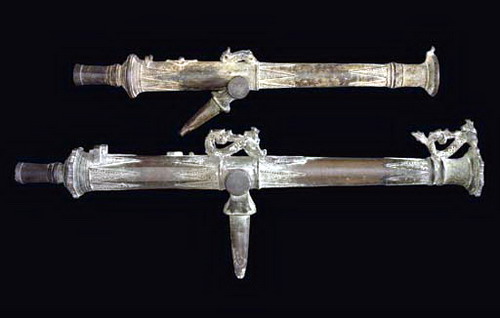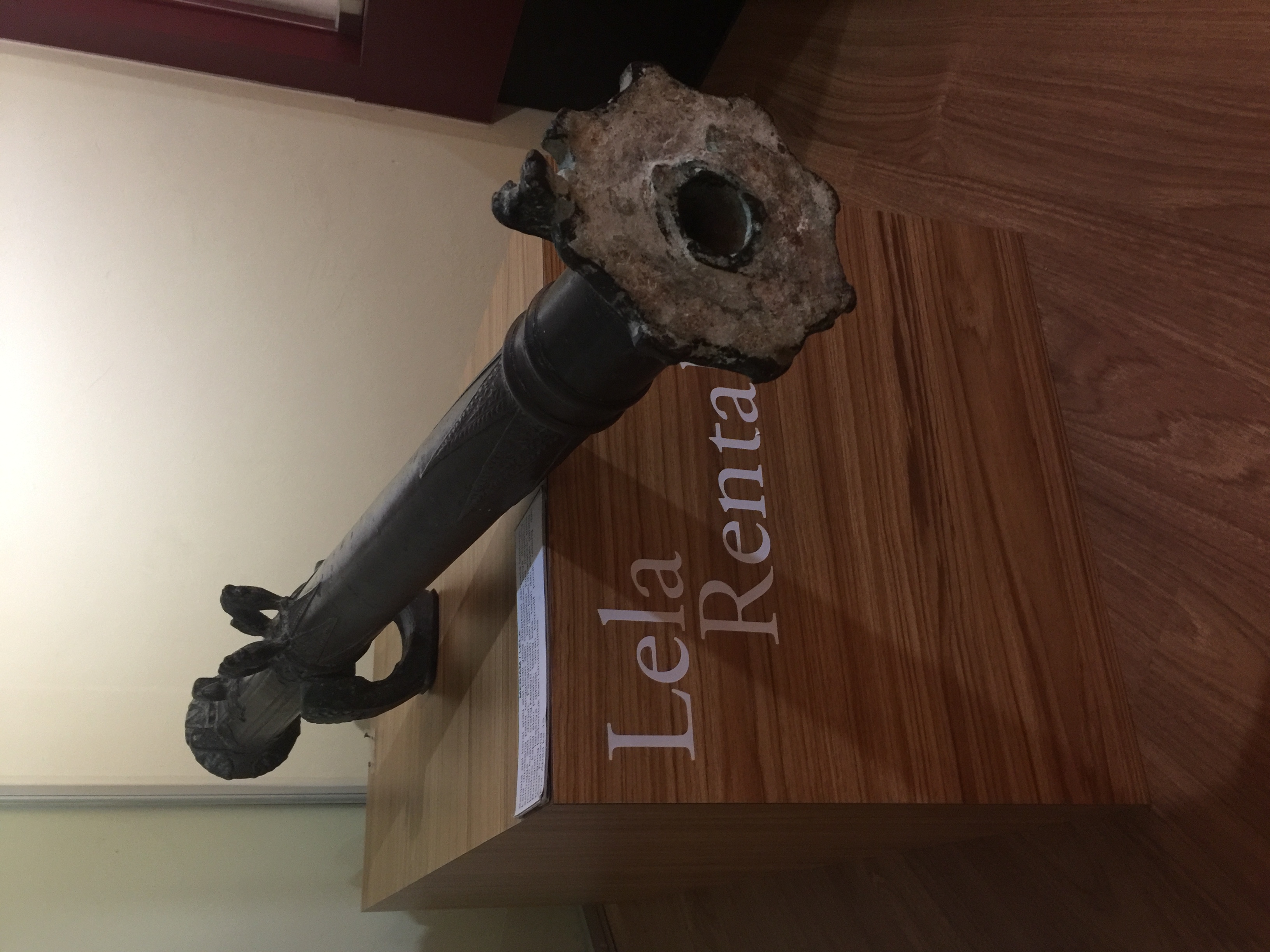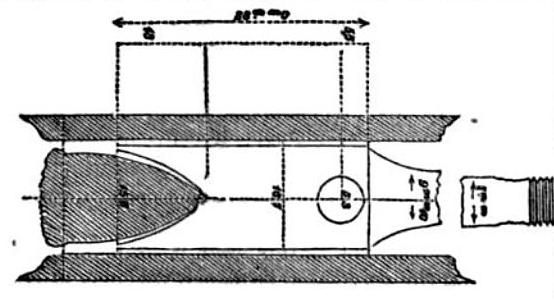|
Rentaka
The ''Lantaka'' (Baybayin: pre virama: ''ᜎᜆᜃ'': post virama: ''ᜎᜈ᜔ᜆᜃ'') also known as ''rentaka'' (In Malay) was a type of bronze portable cannon or swivel gun, sometimes mounted on merchant vessels and warships in Maritime Southeast Asia. It was commonly equipped by native seafaring vessels from the Philippines, Indonesia, Brunei, and Malaysia. Lela and rentaka are known by the Malays as ''meriam kecil'' (lit. "small cannon"), the difference is that rentaka is smaller in length and bore than a lela. and Lantakas are often called ''Kanyon'' in Filipino (literal meaning Cannon). The ''lantaka'' was cited by the National Commission for Culture and the Arts of the Philippines as an intangible cultural heritage of the country under the 'Traditional Craftsmanship' category that the government may nominate in the UNESCO Intangible Cultural Heritage Lists. The documentation of the craft was aided by ICHCAP of UNESCO. Etymology The name may stem from the Malay ... [...More Info...] [...Related Items...] OR: [Wikipedia] [Google] [Baidu] |
Lela (cannon)
Lela or lila is a type of Malay cannon, used widely in the Nusantara archipelago. They are similar to a lantaka but longer and had larger bore. Lela can be configured as swivel gun, fixed gun, or mounted in a gun carriage. It is the equivalent of European falcon and falconet. Etymology The cannon was named after a heroine of the Malay classic romance story called "Laila Majnun". It seems that the adoption of the word stems from the name given to some particular piece. The customs of naming special cannon was not uncommon in Europe in the early days and also in Nusantara to the recent times. On Malay literature the name is usually coupled with rentaka, as "lela rentaka". It is also called as lilla by the Dutch and lelo in several parts of the archipelago. Description Usually lela are about 100–180 cm long and made from brass or bronze. They are firing 1.13–1.36 kg (2.5 lb–3 lb) round shot with a range of over 360 m. Alternatively they can also be ... [...More Info...] [...Related Items...] OR: [Wikipedia] [Google] [Baidu] |
Rentaka Melayu
The ''Lantaka'' (Baybayin: pre virama: ''ᜎᜆᜃ'': post virama: ''ᜎᜈ᜔ᜆᜃ'') also known as ''rentaka'' (In Malay) was a type of bronze portable cannon or swivel gun, sometimes mounted on merchant vessels and warships in Maritime Southeast Asia. It was commonly equipped by native seafaring vessels from the Philippines, Indonesia, Brunei, and Malaysia. Lela and rentaka are known by the Malays as ''meriam kecil'' (lit. "small cannon"), the difference is that rentaka is smaller in length and bore than a lela. and Lantakas are often called ''Kanyon'' in Filipino (literal meaning Cannon). The ''lantaka'' was cited by the National Commission for Culture and the Arts of the Philippines as an intangible cultural heritage of the country under the 'Traditional Craftsmanship' category that the government may nominate in the UNESCO Intangible Cultural Heritage Lists. The documentation of the craft was aided by ICHCAP of UNESCO. Etymology The name may stem from the Malay ... [...More Info...] [...Related Items...] OR: [Wikipedia] [Google] [Baidu] |
Malays (ethnic Group)
Malays ( ms, Orang Melayu, Jawi: أورڠ ملايو) are an Austronesian ethnic group native to eastern Sumatra, the Malay Peninsula and coastal Borneo, as well as the smaller islands that lie between these locations — areas that are collectively known as the Malay world. These locations are today part of the countries of Malaysia, Indonesia (eastern and southern Sumatra, Bangka Belitung Islands, western coastal Borneo ( Kalimantan) and Riau Islands), southern part of Thailand ( Pattani, Satun, Songkhla, Yala and Narathiwat), Singapore and Brunei Darussalam. There is considerable linguistic, cultural, artistic and social diversity among the many Malay subgroups, mainly due to hundreds of years of immigration and assimilation of various regional ethnicity and tribes within Maritime Southeast Asia. Historically, the Malay population is descended primarily from the earlier Malayic-speaking Austronesians and Austroasiatic tribes who founded several ancient mariti ... [...More Info...] [...Related Items...] OR: [Wikipedia] [Google] [Baidu] |
Ramrod
A ramrod (or scouring stick) is a metal or wooden device used with muzzleloading firearms to push the projectile up against the propellant (mainly blackpowder). The ramrod was used with weapons such as muskets and cannons and was usually held in a notch underneath the barrel. Bullets that did not fit snugly in the barrel were often secured in place by a wad of paper or cloth, but either way, ramming was necessary to place the bullet securely at the rear of the barrel. Ramming was also needed to tamp the powder so that it would explode properly instead of fizzle (this was a leading cause of misfires). The ramrod could also be fitted with tools for various tasks such as cleaning the weapon, or retrieving a stuck bullet. Cap and ball revolvers were loaded a bit like muzzleloaders—powder was poured into each chamber of the cylinder from the muzzle end, and a bullet was then squeezed in. Such handguns usually had a ramming mechanism built into the frame. The user pulled a l ... [...More Info...] [...Related Items...] OR: [Wikipedia] [Google] [Baidu] |
Mongol Invasion Of Java
The Yuan dynasty under Kublai Khan attempted in 1292 to invade Java, an island in modern Indonesia, with 20,000 to 30,000 soldiers. This was intended as a punitive expedition against Kertanegara of Singhasari, who had refused to pay tribute to the Yuan and maimed one of their emissaries. However, in the intervening years between Kertanegara's refusal and the expedition's arrival on Java, Kertanegara had been killed and Singhasari had been usurped by Kediri. Thus, the Yuan expeditionary force was directed to obtain the submission of its successor state, Kediri, instead. After a fierce campaign, Kediri surrendered, but the Yuan forces were betrayed by their erstwhile ally, Majapahit, under Raden Wijaya. In the end, the invasion ended with Yuan failure and victory for the new state, Majapahit. Background Kublai Khan, the founder of the Yuan dynasty, had sent envoys to many states demanding that they pay tributes and submit themselves to the Mongol empire (Yuan dynasty). Men-shi ... [...More Info...] [...Related Items...] OR: [Wikipedia] [Google] [Baidu] |
Nusantara (archipelago)
''Nusantara'' is the Indonesian name of Maritime Southeast Asia (or parts of it). It is an Old Javanese term that literally means "outer islands". In Indonesia, it is generally taken to mean the Indonesian Archipelago. Outside of Indonesia, the term has been adopted to refer the Malay Archipelago. The word Nusantara is taken from an oath by Gajah Mada in 1336, as written in the Old Javanese ''Pararaton'' and ''Nagarakretagama''. Gajah Mada was a powerful military leader and prime minister of Majapahit credited with bringing the empire to its peak of glory. Gajah Mada delivered an oath called '' Palapa oath'', in which he vowed not to eat any food containing spices until he had conquered all of Nusantara under the glory of Majapahit. The concept of Nusantara as a unified region was not invented by Gajah Mada in 1336. The term Nusantara was first used by Kertanegara of Singhasari in Mula Malurung inscription dated 1255. Furthermore, in 1275, the term ''Cakravala Mandala Dv ... [...More Info...] [...Related Items...] OR: [Wikipedia] [Google] [Baidu] |
Gunpowder
Gunpowder, also commonly known as black powder to distinguish it from modern smokeless powder, is the earliest known chemical explosive. It consists of a mixture of sulfur, carbon (in the form of charcoal) and potassium nitrate ( saltpeter). The sulfur and carbon act as fuels while the saltpeter is an oxidizer. Gunpowder has been widely used as a propellant in firearms, artillery, rocketry, and pyrotechnics, including use as a blasting agent for explosives in quarrying, mining, building pipelines and road building. Gunpowder is classified as a low explosive because of its relatively slow decomposition rate and consequently low brisance. Low explosives deflagrate (i.e., burn at subsonic speeds), whereas high explosives detonate, producing a supersonic shockwave. Ignition of gunpowder packed behind a projectile generates enough pressure to force the shot from the muzzle at high speed, but usually not enough force to rupture the gun barrel. It thus makes a good pro ... [...More Info...] [...Related Items...] OR: [Wikipedia] [Google] [Baidu] |
Kingdom Of Portugal
The Kingdom of Portugal ( la, Regnum Portugalliae, pt, Reino de Portugal) was a monarchy in the western Iberian Peninsula and the predecessor of the modern Portuguese Republic. Existing to various extents between 1139 and 1910, it was also known as the Kingdom of Portugal and the Algarves after 1415, and as the United Kingdom of Portugal, Brazil and the Algarves between 1815 and 1822. The name is also often applied to the Portuguese Empire, the realm's overseas colonies. The nucleus of the Portuguese state was the County of Portugal, established in the 9th century as part of the '' Reconquista'', by Vímara Peres, a vassal of the King of Asturias. The county became part of the Kingdom of León in 1097, and the Counts of Portugal established themselves as rulers of an independent kingdom in the 12th century, following the battle of São Mamede. The kingdom was ruled by the Alfonsine Dynasty until the 1383–85 Crisis, after which the monarchy passed to the House of Aviz ... [...More Info...] [...Related Items...] OR: [Wikipedia] [Google] [Baidu] |
Dutch Republic
The United Provinces of the Netherlands, also known as the (Seven) United Provinces, officially as the Republic of the Seven United Netherlands ( Dutch: ''Republiek der Zeven Verenigde Nederlanden''), and commonly referred to in historiography as the Dutch Republic, was a federal republic that existed from 1579, during the Dutch Revolt, to 1795 (the Batavian Revolution). It was a predecessor state of the Netherlands and the first fully independent Dutch nation state. The republic was established after seven Dutch provinces in the Spanish Netherlands revolted against rule by Spain. The provinces formed a mutual alliance against Spain in 1579 (the Union of Utrecht) and declared their independence in 1581 (the Act of Abjuration). It comprised Groningen, Frisia, Overijssel, Guelders, Utrecht, Holland and Zeeland. Although the state was small and contained only around 1.5 million inhabitants, it controlled a worldwide network of seafaring trade routes. Through it ... [...More Info...] [...Related Items...] OR: [Wikipedia] [Google] [Baidu] |
Pahang Sultanate
The Pahang Sultanate (Malay: ''Kesultanan Pahang'', Jawi: كسلطانن ڤهڠ ) also referred as the Old Pahang Sultanate, as opposed to the Modern Pahang Sultanate, was a Malay Muslim state established in the eastern Malay peninsula in 15th century. At the height of its influence, the Sultanate was an important power in Southeast Asian history and controlled the entire Pahang basin, bordering to the north, the Pattani Sultanate, and adjoins to that of Johor Sultanate to the south. To the west, it also extends jurisdiction over part of modern-day Selangor and Negeri Sembilan. The sultanate has its origin as a vassal to Melaka, with its first Sultan was a Melakan prince, Muhammad Shah, himself the grandson of Dewa Sura, the last pre-Melakan ruler of Pahang. Over the years, Pahang grew independent from Melakan control and at one point even established itself as a rival state to Melaka until the latter's demise in 1511. During this period, Pahang was heavily involved in atte ... [...More Info...] [...Related Items...] OR: [Wikipedia] [Google] [Baidu] |
Malacca Sultanate
The Malacca Sultanate ( ms, Kesultanan Melaka; Jawi script: ) was a Malays (ethnic group), Malay sultanate based in the modern-day state of Malacca, Malaysia. Conventional historical thesis marks as the founding year of the sultanate by King of Singapura, Parameswara (king), Parameswara, also known as Iskandar Shah, although earlier dates for its founding have been proposed. At the height of the sultanate's power in the 15th century, its capital grew into one of the most important entrepôt, transshipment ports of its time, with territory covering much of the Malay Peninsula, the Riau Islands and a significant portion of the northern coast of Sumatra in present-day Indonesia. As a bustling international trading port, Malacca emerged as a centre for Islamic learning and dissemination, and encouraged the development of the Malay language, Malaysian literature, literature and arts. It heralded the Golden Age, golden age of Malay sultanates in the archipelago, in which Classical Ma ... [...More Info...] [...Related Items...] OR: [Wikipedia] [Google] [Baidu] |
Foundries
A foundry is a factory that produces metal castings. Metals are cast into shapes by melting them into a liquid, pouring the metal into a mold, and removing the mold material after the metal has solidified as it cools. The most common metals processed are aluminum and cast iron. However, other metals, such as bronze, brass, steel, magnesium, and zinc, are also used to produce castings in foundries. In this process, parts of desired shapes and sizes can be formed. Foundries are one of the largest contributors to the manufacturing recycling movement, melting and recasting millions of tons of scrap metal every year to create new durable goods. Moreover, many foundries use sand in their molding process. These foundries often use, recondition, and reuse sand, which is another form of recycling. Process In metalworking, casting involves pouring liquid metal into a mold, which contains a hollow cavity of the desired shape, and then allowing it to cool and solidify. The solidified ... [...More Info...] [...Related Items...] OR: [Wikipedia] [Google] [Baidu] |


.jpg)




